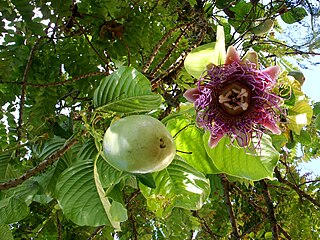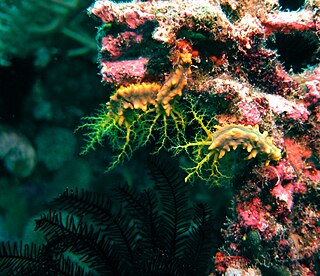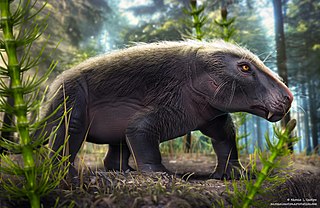
Passiflora quadrangularis, the giant granadilla, barbadine (Trinidad), grenadine (Haiti), giant tumbo or badea, is a species of plant in the family Passifloraceae. It produces the largest fruit of any species within the genus Passiflora. It is a perennial climber native to the Neotropics.

Cissus is a genus of approximately 350 species of lianas in the grape family (Vitaceae). They have a cosmopolitan distribution, though the majority are to be found in the tropics.
Alona is a genus of cladocerans in the family Chydoridae. It is one of the largest genera of Cladocera, and is widely believed to be an artificial group which is in need of systematic revision; the type species is Alona quadrangularis. Around 240 names at the species level have been described in Alona; it is unclear how many of these are valid, or how they are related.
Erithalis quadrangularis is a species of plant in the family Rubiaceae. It is endemic to Jamaica.
Melicope quadrangularis, also called four angle melicope or four-angled pelea, is a species of plant in the family Rutaceae. It is endemic to the Hawaiian Islands, where it is known only from the island of Kauai. It is threatened by habitat loss.
Tarenna quadrangularis is a species of plant in the family Rubiaceae. It is endemic to Tanzania.

Cicendia is a small genus of plants in the gentian family which contains only two species of tiny yellow annual wildflowers. Cicendia filiformis, the slender cicendia or yellow centaury, is native to Europe and naturalized in other places, such as Australia. Cicendia quadrangularis, the Oregon timwort, is native to western North America and South America.

Lepyronia quadrangularis is a species of spittle bug that can be found in many places in the world. The adults are brownish with two oblique darker brown bands that strike across their fore wings. The fore wings are also marked with a small blackish curve at their tips. The eggs are laid between the leaf and the main stem of grasses from midsummer to late fall. The nymphs feed and molt under spittle and hibernate in the egg stage. Lepyronia quadrangularis is polyphagous, feeding upon a variety of grasses, shrubs, and herbs. Its common name is diamond-backed spittle bug.

Cissus quadrangularis is a perennial plant of the grape family. It is commonly known as veldt grape, winged treebine or adamant creeper. The species is native to tropical Asia, the Arabian Peninsula and much of Africa.

Passiflora nitida, the bell apple, is a tasty, but relatively unknown passion fruit. It is similar to P. laurifolia, with orange-yellow fruits that have a sweet, succulent pulp. It is a fast-growing tropical vine. Its flowers are blue and red, a bit like P. laurifolia and P. quadrangularis. The fruits grow up to 4 centimetres (1.6 in). The exact hardiness in unknown, but it is tropical and should be protected from prolonged temperatures below 50–55 °F (10–13 °C). It is not frost hardy. Passiflora nitida is the cousin of almost all the Passiflora species like P. actinia, P. flavicarpa, P. loefgrenii and so on. Its propagation is by seeds. The fruits are eaten fresh and reportedly quite good in flavor. The bell apple is a native to the Amazon jungle region. Passiflora nitida is also a useful fruit in a drink called Purple Passion. Passiflora nitida has one of the widest geographic ranges. It grows in the tropical lowlands from Costa Rica in the north and French Guiana in the northeast, through wide parts of Brazil.
Quadrangularis means "quadrangular" in Latin. Quadrangularis is the species name in the binomial nomenclature of several species:

The Fali people are any of several small ethnic groups of Africa. The Fali are concentrated in mountainous areas of northern Cameroon, but some also live in northeastern Nigeria. The Fali are composed of four major groups, each corresponding to a geographic region: The Bossoum Fali, the Kangou Fali, the Peske–Bori Fali, and the Tingelin Fali. The Fali in Cameroon have been described as being centered on Garoua as well as the rocky plateaus and peaks of the Adamawa mountains in the country's north. The Fali are sometimes referred to as the Kirdi, meaning "pagan," a term given by the neighboring Muslim Fulani; after they fought against the jihadists and rejected Islam. Today the Fali in Mubi North Adamawa state are predominantly Christians.

Colochirus quadrangularis, commonly known as the thorny sea cucumber, is a species of sea cucumber in the family Cucumariidae. It is found in shallow seas in tropical parts of the Indo-Pacific region.

Quadrangularin A is an oligostilbene found in Cissus quadrangularis and in Parthenocissus laetevirens. It is a resveratrol dimer.

Rhigospira is a genus of flowering plants in the family Apocynaceae, first described as a genus in 1878 by John Miers. The species, Rhigospira quadrangularis was first described as Ambelania quadrangularis by Johannes Müller Argoviensis in 1860 but was transferred to the genus, Rhigospira, in 1878 by John Miers. The genus contains only one known species, Rhigospira quadrangularis, native to northwestern South America.

Siriusgnathus is a traversodontid cynodont from the Carnian channel sandstones and mudstones of the Candelária Formation, belonging to the Santa Maria Supersequence of the Paraná Basin in southeastern Brazil. It includes one species, Siriusgnathus niemeyerorum and was described in 2018. The species epithet refers to the Niemeyer locality in Agudo, Rio Grande do Sul. It was found together with various archosauromorphs, dinosauromorphs and other cynodonts, such as Brasilitherium riograndensis, Brasilodon quadrangularis, Irajatherium hernandezi and Prozostrodon brasiliensis.
Pseudotritonia quadrangularis is a species of sea slug, an aeolid nudibranch, a shell-less marine gastropod mollusk in the family Charcotiidae.

Funiculina quadrangularis, commonly known as tall sea pen, is an uncommon cold water coral within the Family Funiculinidae. It is named tall sea pen because it looks like a quill sticking in the bottom of the sea. It forms habitat for several key crustacean species.

Peperomia quadrangularis, commonly known as the beetle peperomia, is a species of plant in the genus Peperomia of the family Piperaceae. Its native range is in tropical America, including areas in northern South America, Central America and the West Indies.













